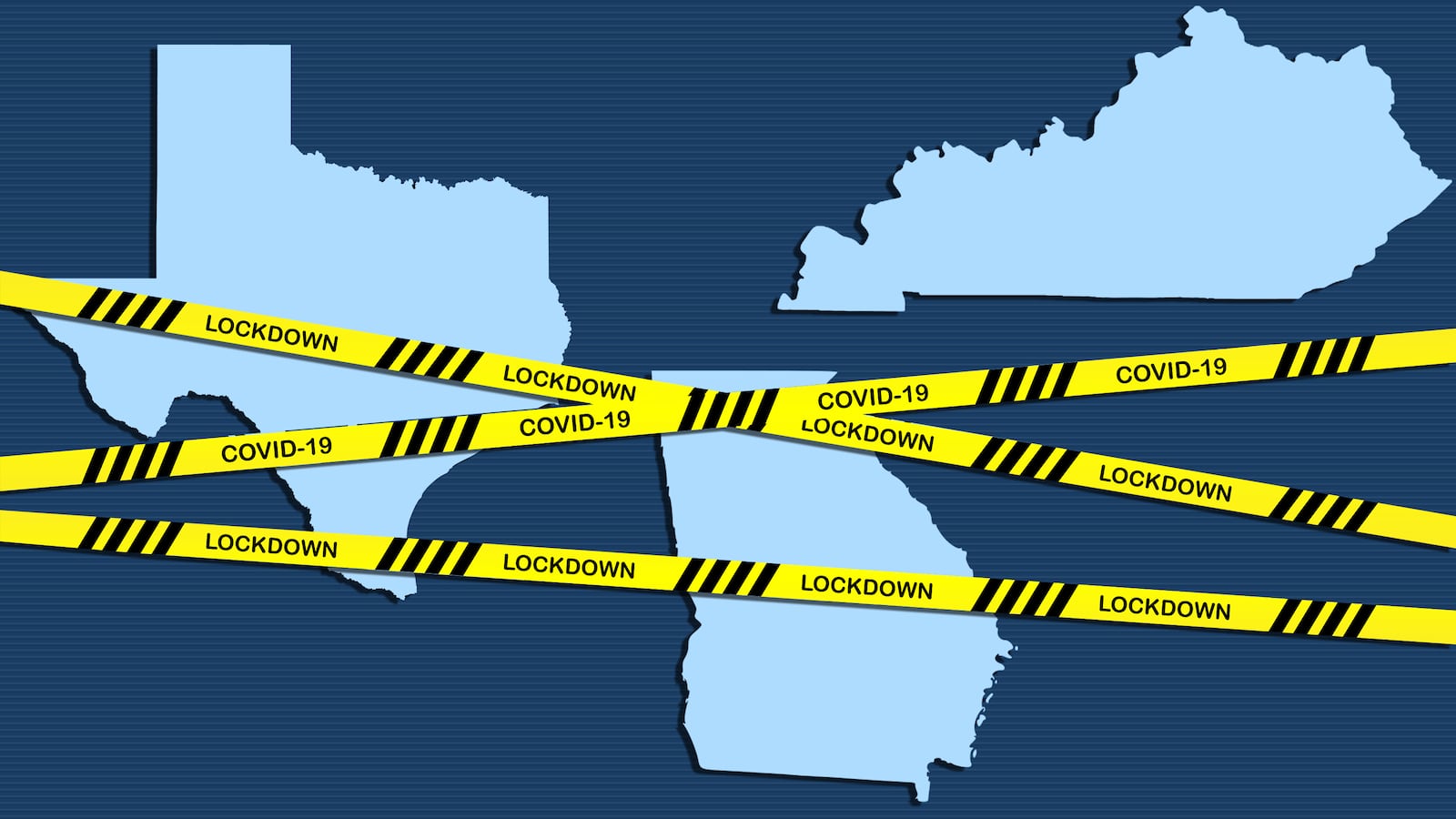As states rush to reopen after pandemic-triggered lockdowns, public health experts say new surges could soon warrant a second set of stay-at-home orders.
Of course, it remains far from clear that some of these same states’ governors—who were often slow to lock down in the first place—will be willing to do it. The political pressure to restart economies and release people from isolation has been fierce. But failing to act again, however painful, could see the same states overwhelmed by COVID-19 cases.
Entire countries have already been forced to lock down a second time, like Lebanon announced it would on Wednesday, after case numbers jumped from 750 on May 5 to 870 on Tuesday. Meanwhile, more than four in five Americans have said they are concerned or afraid of a potential second wave of cases, according to a CNN-SSRS poll.
According to documents obtained by NBC News from a May 7 White House coronavirus task force report, infection rates in several states had spiked by 72.4 percent or more in a single week. That information clashed with claims by President Trump on Monday that “all throughout the country, the numbers are coming down rapidly.”
But among the areas with the largest reported spikes were Amarillo, Texas, and Central City, Kentucky, the latter of which recorded a whopping 650 percent increase in confirmed cases compared to the previous week. The documents were created by the data and analytics unit of the task force, according to NBC. (In the case of Central City, a local spike appeared to be explained at least in part by an outbreak that killed at least three inmates and sickened at least 406 others at the Green River Correctional Complex, where targeted mass testing was performed.)
These numbers, if accurate, paint a striking picture of the novel coronavirus pandemic spreading quickly, and not just in early hot spots or major coastal centers. Instead, they point to emerging epidemiological trouble in locales where governors were quick to follow President Trump’s advice to relax stay-at-home restrictions.
Christopher Johnson, professor and chair for the Department of Health Management and Systems Sciences at the University of Louisville, said preliminary modeling done by his group for Jefferson County, Kentucky found that if the post-lockdown contact rate between citizens more than doubles from what it was during restrictions, “a second surge will be inevitable, even if we perfectly identify and isolate those with the virus.”
So it’s only natural that, as Johnson said, “An uncalculated opening—not developing the testing and contact-tracing capacities and not making a careful and gradual opening—increases the possibility of a second surge or putting us on an unstable path in terms of infections and hospitalization.”
As of of Monday, Kentucky Gov. Andy Beshear allowed several nonessential sectors to reopen their businesses, including construction, vehicle dealerships, offices (at 50 percent capacity), horse racing (without fans), pet care, photography, and manufacturing. Beshear’s office did not respond to a request for comment on Tuesday from The Daily Beast. As of Tuesday afternoon, Kentucky had 6,677 confirmed cases and 311 deaths.
The analysis, Johnson said, merged Jefferson County local data with aggregated, anonymized cellphone data compiled by Google from Feb. 15 through April 30, with updated results expected soon. It showed that social distancing practices in grocery stores and pharmacies were “nearly significantly protective” from infection and that social distancing practices in parks were “significantly protective.” Meanwhile social distancing practices affecting residential movement, like people visiting friends at their home, had “little or no detectable effect.”
However, Johnson added, the analysis also found that social distancing practices on public transit and in the workplace were not only not protective but were “significantly increasing the spread of the virus,” meaning they needed to be “greatly” improved.
The simple takeaway here, he explained, is that social distancing in these settings hasn’t been working well enough even under restrictions—people have not standing far enough apart or engaging in other cautious behavior with sufficient care to prevent infection. Google’s data used the same kind of aggregated and anonymized information used to show popular times for places on Google Maps, comparing against a baseline determined to be a median value for the corresponding day of the week during a five-week period. The insights, according to Google, are based on data from users who have opted in to Location History.
The findings from Johnson’s analysis bolster reporting from the Associated Press, which found that thousands have come down with COVID-19 at work—from state prisons and meatpacking plants to the West Wing of the White House and construction workers in Austin, Texas.
This is a problem in states that are not open yet, but it’s especially glaring in those that are taking steps to jumpstart business.
Dr. Mark Escott, a regional health official, told Austin’s city council that “the people who are getting sick right now are generally people who are working” and “that risk is going to increase the more people are working.”
The same thing could play out in Kentucky as its reopening progresses.
“If confirmed cases, hospitalizations, ICU bed counts, ventilator usage or fatalities are increasing again, we are on the wrong path,” said Johnson. “If we do see evidence that there is a second surge and the governor does not take the steps to restrict contact again, it could be very dangerous.”
Dr. Pritesh Gandhi—an Austin-based primary care doctor and a candidate for Texas’ 10th Congressional District—said he had “little doubt that Texas and the country will face a second surge” because it opened without adequate testing and contact tracing in place. But like other leaders who face pressure to reopen their economies, it was far from clear that Gov. Greg Abbott would ever reimplement a lockdown or stay-at-home order, since he reopened the state while case counts were still climbing and even admitted cases were likely to follow.
Abbott’s office did not respond to a request for comment from The Daily Beast on Tuesday, but he said earlier this month during a press conference that there will be “surge response teams” sent to address flare ups as they arise throughout the state. But even when Abbott announced his initial executive lockdown order and asked people to stay home, he said, “This is not a stay-at-home strategy. This is a standard that is based on essential services and essential activities.”
As of Tuesday afternoon, Texas had 40,555 confirmed cases and 1,117 deaths.
“I’m most concerned about elected officials playing politics with this pandemic,” said Gandhi. “The White House frames this debate as between opening up the economy vs believing public health experts. That’s a false dilemma. We do not have to accept thousands of deaths as inevitable, nor do we need to accept skyrocketing unemployment. The governor needs to have the political will to invest significant resources in the public health infrastructure of Texas.”
“Doing so will save lives and our economy at the same time,” said Gandhi.
But this matters even for states that might not be at the top of COVID case-trackers. Take Georgia, for example.
Last month, a team of researchers at Harvard, MIT, and Georgia Tech released a state-by-state COVID-19 simulator, which showed that under minimal restrictions, with no other interventions following the lifted lockdown, there could be up to 20,000 deaths by Aug. 30 in Georgia. Turgay Ayer, an associate professor at Georgia Institute of Technology’s School of Industrial and Systems Engineering, who worked on the project, previously told The Daily Beast that such a worst-case scenario could be avoided. But only if Gov. Brian Kemp, who led the charge nationally in reopening his state, were to reimplement some restrictions in the event of a second wave.
“We have evidence that increased mobility is associated with increased spread in the community, and hence ultimately increased numbers of cases and deaths,” Ayer added, in an interview on Tuesday. “We do not have evidence yet about an increase in the numbers of cases due to 14 days of lag time in reporting in Georgia, [but] our analysis shows that mobility has been already increasing.”
“It is highly likely to see a second wave in Georgia,” he said, noting that his team’s simulator shows “the case numbers are likely to increase initially slowly but then faster and peak in the fall.”
Gov. Brian Kemp on Tuesday held an afternoon press conference, where he extended closures of bars, updated some guidelines for restaurants, and laid out plans to enable summer camps to operate beginning on May 14, provided they meet 32 requirements. Kemp said that he strongly urged residents to continue to wear face masks in public spaces.
“We are just in a good place,” Kemp said, “and we want to keep these numbers moving in the right direction.”
Kemp’s office declined to answer questions from The Daily Beast on Tuesday about whether he would consider closing the state back down in the event of a surge.
“If we see a consistent trend of increasing new daily cases for a week or at most two weeks, another shutdown or other restrictions are needed,” argued Dr. Andreas Handel, an infectious disease epidemiologist and an associate professor at the University of Georgia’s Department of Epidemiology and Biostatistics. “Since there is a delay between cases and hospitalizations, I think watching case numbers carefully is the best indicator.”
As of Tuesday afternoon, Georgia had 34,002 confirmed cases and 1,444 deaths.
“If spread is increasing back to the levels at the beginning of the outbreak,” Handel added, “in a worst-case scenario we could see around 5 million infections and 50,000 deaths in Georgia.”



